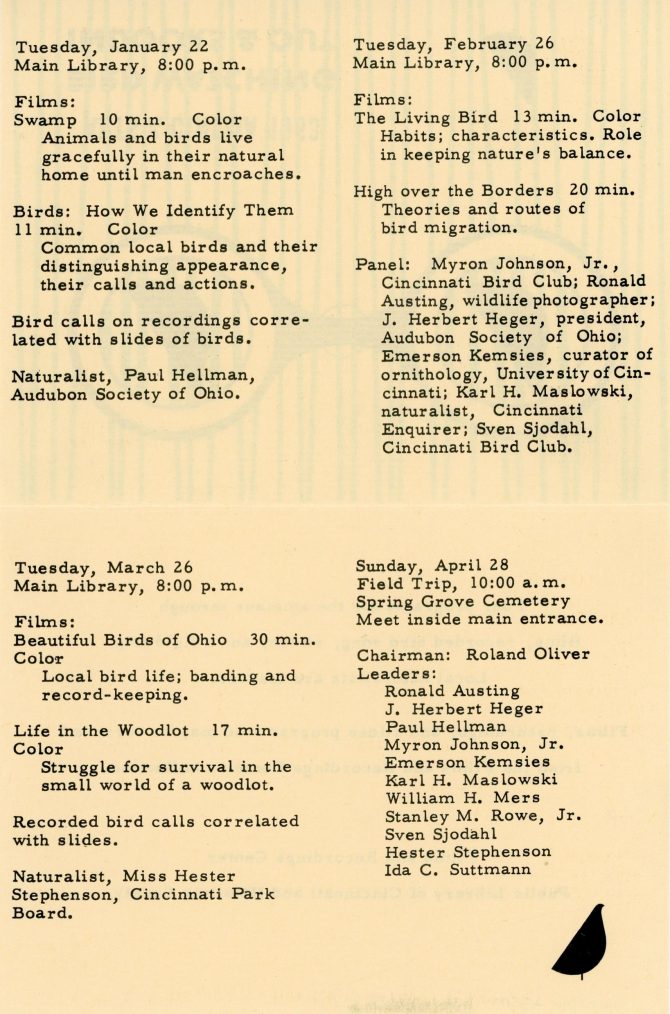
Bird Nerds
Join the Library's flock of first-time birders eagle-eyed listers!
Attend events with fellow feather-fans and celebrate all things avian with the CHPL Bird Nerds.
Join the CHPL Bird Nerds Flock
Attend an upcoming CHPL Bird Nerds event, including a monthly Mindful Birdwatching series.
Borrow books, movies, magazines, and more that feature everything from Abbott's babblers to Zone-tailed hawks.
View one of the the few remaining intact copies of John James Audubon’s Birds of America.

Upcoming Events
Bird Nerd Events
Books for Birders
Birdwatching Staff Lists
Celebrate 60 Years of Birdwatching!

Mark six decades of CHPL birdwatching with this self-guided tour through gorgeous Spring Grove Cemetery and Arboretum!
Biographies of Featured Individuals
Learn more about the naturalists, artists, and bird lovers featured on the self-guided tour.
CHARLEY & EDIE HARPER: While Charley Harper is widely celebrated for his bird & wildlife paintings, in 1955 Harper created two art pieces related to the Downtown Main Library. One is a painting of the then new Main Library for Ford Times magazine. Harper also designed the “Sight & Sound photomural” for the Film & Recordings Department. Edie McKee Harper was an American photographer, artist and wildlife conservationist. Charley & Edie Harper both have ArtWorks murals, celebrating their talents, just steps away from the Downtown Main Library.
CORNELIUS HAUCK: As an avid horticulturist, Hauck planted 900 types of trees, shrubs, and evergreens on his property. He also patented a new variety of lilac and donated his extensive library on botany, horticulture, and landscape design to the Cincinnati Historical Society. Hauck served on the Park Board for 18 years and willed the property to the city. His former estate, which he referred to as Sooty Acres, is a splendid eight-acre Botanic Garden located in Avondale. The CHPL Bird Nerds will be hosting Mindful Birdwatching mornings, the 3rd Saturday of the month, May – Sept. in this urban oasis.
JOHN RUTHVEN: As a child, Ruthven would frequent the Walnut Hills Branch Library but revealed to staff that his most memorable library experience was traveling to the Downtown Main Library to view John James Audubon’s “Birds of America.” In 2015 the Library Board of Trustees dedicated the new state-of-the-art exhibit cases housing the four elephant folio volumes of “Birds of America” to Mr. Ruthven, hailing him as “Our 20th Century Audubon."
John’s stunning ArtWorks “Martha” mural, depicting the now extinct Passenger Pigeon, located at 8th & Vine St., is visible from Downtown Main Library’s south-facing windows.
JOSEPH MASON: In 1820 at the tender age of twelve, Mason, a Cincinnati native, apprenticed for John James Audubon. Mason's job was to paint the background floral elements of Audubon's bird paintings for the historic book "Birds of America." For twenty-one months, Mason accompanied Audubon in the field and painted over fifty floral backgrounds in watercolor. It appears that Audubon may not have intended to give Mason credit for his work, as he had Mason sign his name in pencil while he signed his own name to the finished works in ink.
In 1821, Mason returned to the Queen City and became a successful portrait painter, working out of his studio at Fourth and Main in downtown Cincinnati.
ADOLPH STRAUCH: Adolph Strauch was a renowned landscape architect born in Silesia, Prussia, known particularly for his layout design of Historic Spring Grove Cemetery and Arboretum. He also laid out many of Cincinnati’s parks including; Mount Storm, Eden Park, Burnet Woods and Lincoln Park. Strauch was hired by Spring Grove Cemetery in 1855 to handle the landscaping, and became superintendent in 1859.
E. LUCY BRAUN: Braun was an expert on the forests of the eastern United States and a professor at the University of Cincinnati. She was an environmentalist before the term was popularized, and a pioneering woman in the fields of botany and ecology, winning many awards for her work. In the 1920s and 1930s, Braun's work included a new catalog of the flora of the Cincinnati area, with a comparison to the flora of 100 years prior. Her study, one of the first of its kind for the United States, provided a model for analyzing changes to a flora over time. Dr. Conover, the host of today’s guided tour, is conducting a botanical survey in Greater Cincinnati which continues the work of Braun’s 1934 publication “The Lea Herbarium and the Flora of Cincinnati.”



